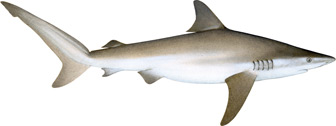
More than 100 of the world’s 370 plus species of shark live in Western Australian (WA) waters.
These range from the 30cm pygmy shark to the world’s biggest fish, the gentle whale shark, which grows up to 12m long and is a popular feature of the WA aquatic tourism industry.
The presence of many species of shark as 'apex' and 'meso' predators – occupying the top levels of the food chain – is an indication of a healthy marine environment.
Despite their reputation, sharks seldom cause harm to humans, however, when incidents do occur the results can be devastating. We have therefore established a Shark Response Unit to conduct additional research into sharks and work on ways to improve public safety.
Concerns about shark stocks in the 1990s led to big reductions in fishing effort and catches in WA’s shark fisheries. Only a few commercial fisheries are authorised to keep their shark and ray catches for sale and these fisheries operate under strict controls to manage their catch levels.
Biology
Sharks are typically slow growing, late maturing, long-lived and produce only a few young per year, making many species particularly vulnerable to overfishing.
Like rays and skates, sharks belong to a class of fish called Chondrichthyes which have skeletons made of cartilage not bone.
Sharks are covered in tough scales known as dermal denticles making their skin extremely tough and abrasive. Sharks have between five and seven external gills.
Some sharks which live on the seabed, such as angel sharks and wobbegongs, have a flattened shape like rays and skates. However, most sharks have a torpedo-shaped body. A large triangular dorsal fin on top of the shark keeps the shark stable. Large, stiff pectoral fins behind the gills are used for steering. The tail or ‘caudal’ fin powers the shark’s swimming. Many sharks must keep swimming in order to breathe.
Sharks, like most fish, typically ‘cruise’ at two – four body lengths per second or less. Burst speeds of up to 10 body lengths per second or more are possible for a short periods of time to obtain prey or escape predators.
Sharks have a continuous supply of teeth, with worn out teeth being replaced as needed. A shark can have up to 3,000 teeth in its mouth at one time and 30,000 plus teeth over its life.
Their teeth vary according to diet. White sharks have large serrated teeth for cutting big prey while grey nurse sharks have long, needle-like teeth, used for gripping. Many rays have teeth modified into grinding plates to grind crabs and other invertebrates.
Shark senses
Sharks have excellent eyesight and an incredible sense of smell.
Like other fish, sharks have clusters of hair-cells called ‘neuromasts’ located in canals just below their skin along the sides of their bodies and around the head and mouth. As with many species of fish, these can sense vibrations caused by fish movements in the water and sound hundreds of metres away.
Through pores in their snouts and heads called ‘ampullae of Lorenzini’, sharks also have the ability to detect the weak electrical signals produced by most living organisms. These pores help them find prey buried in sand or hidden by darkness. It is thought they may also help sharks navigate by responding to fluctuations in the Earth’s magnetic fields.
Upper level predators
Many people are fearful of sharks, but sharks may have more to fear from humans.
Their slow rate of reproduction means many species of sharks are highly vulnerable to overfishing and may take a long time to recover if stocks are overfished.
Sharks can feed on a wide variety of prey, including fish, squid, octopus, crustaceans, mammals, reptiles and other marine creatures. Many species of sharks are specialist feeders, targeting particular prey.
Whale, basking and megamouth sharks filter feed on plankton and have relatively small teeth because they do not need them to feed. Modified extensions on their gills allow the plankton to be filtered from the water.
Because they are at or near the top of aquatic food webs, sharks have few predators, apart from humans, other sharks and orcas.
Life cycle
Whale sharks may live for up to 70 years but most species of shark live between 20 and 40 years.
Sharks are generally slow to mature and some species do not reproduce each year. Fertilisation of young is internal. Many sharks give birth to a small number of well-developed young, called pups. Others may ‘lay’ eggs containing semi-mature embryos in special eggs cases.
The male shark has two ‘claspers’ – analogous to a mammalian penis – immediately behind its pelvic fins but only ever uses one at a time to deliver sperm into the female.
There are three ways sharks produce young:
Most sharks are ovoviparous – eggs hatch in the mother’s body, nourished by the egg’s yolk and fluids secreted by the mother. In the lamniforme sharks, the first embryos to hatch eat the remaining eggs. In some species, including grey nurse sharks, embryos actually feed upon sibling embryos inside the mother.
A few sharks lay their eggs in water, mostly in an egg case with the consistency of leather, which may be corkscrewed into crevices for protection. The empty cases or “mermaid’s purses” can wash up on shore.
Some shark species have a placenta-like link between the mother and developing young, similar to mammals.
Distribution and habitat
Sharks live in every ocean, estuary and freshwater system.
Most species of sharks tend to inhabit shallower continental shelf areas, where rivers deposit nutrients into the oceans, providing the basis of an ocean food web.
Megamouth sharks favour the open ocean while bull sharks are often found many kilometres upriver.
Find out more in our shark fact sheet.
Illustration © R. Swainston/www.anima.net.au